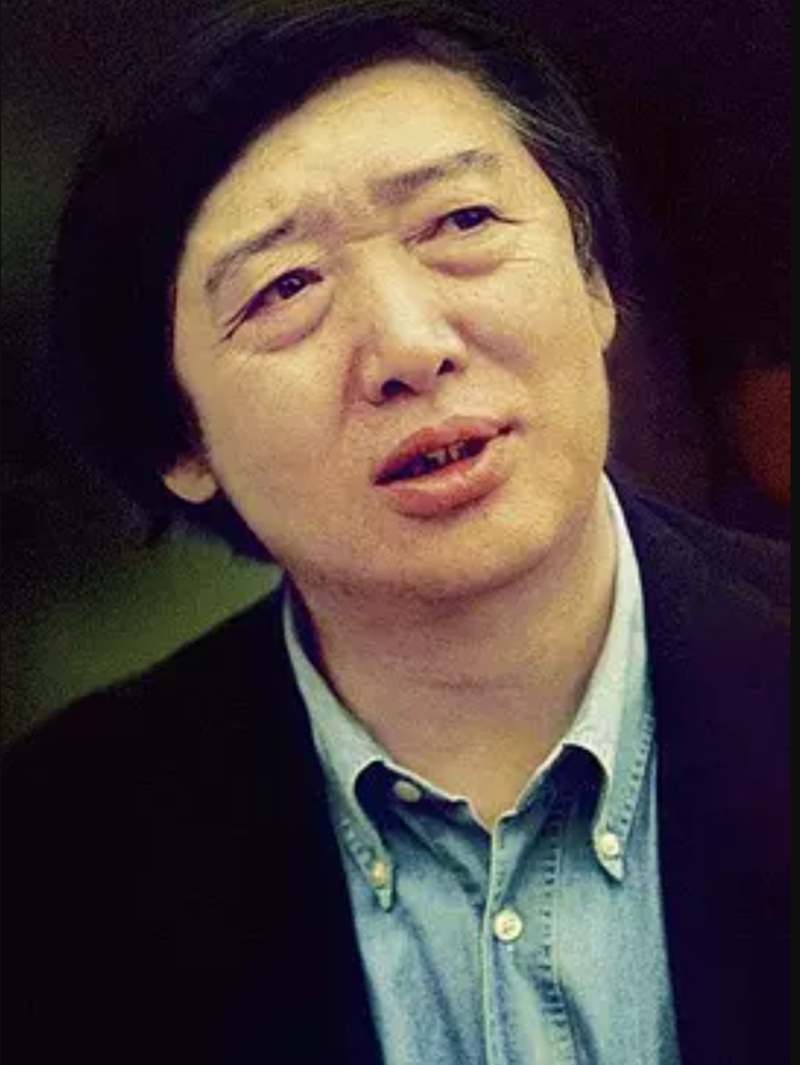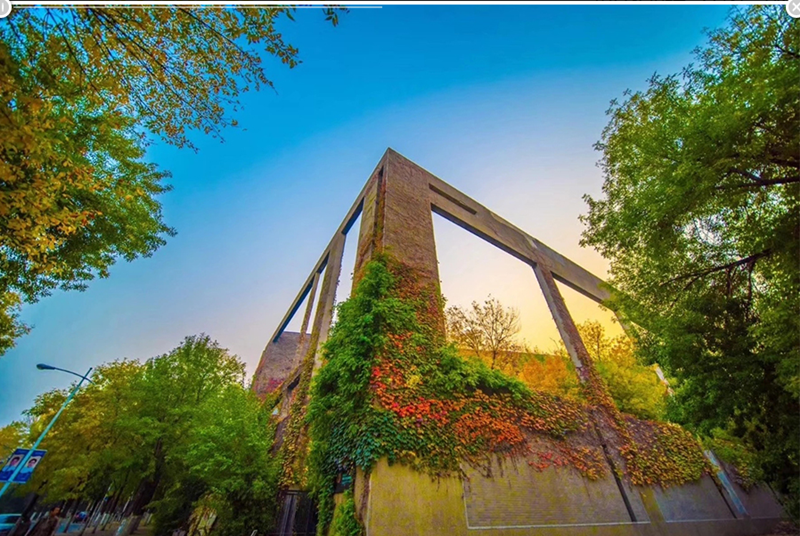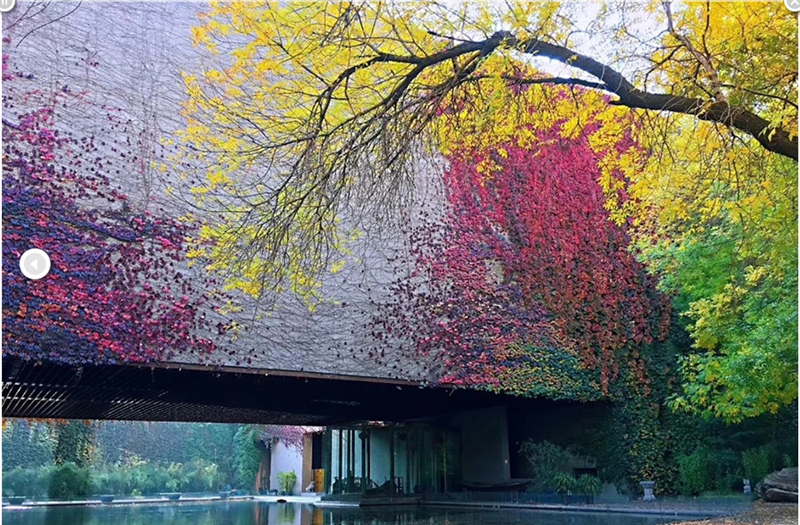There is a special School of Art and Humanity at Tianjin University—Feng Jicai Literature and Art Research Institute, a state of idealism.
Feng Jicai’s Expectation of an Institute

This institute is named for Feng Jicai, the renowned Chinese author, painter and scholar. In 2001, Feng Jicai was appointed as a professor by Tianjin University. Taking Tianjin University as his retreat in his later years, he has been busy organizing his thoughts of his whole life and engaging in research and study. As he said in the opening ceremony of the institute building, “From this day on, the business of Tianjin University will be my business.” Feng Jicai begins to fill the empty building step by step according to his expectation of an institute.
He decorates the institute with nature—ivy clings to the walls naturally, birds tweet among the vine leaves. Colorful fish cruise in the ChengXin pool and all kinds of flowers and plants grow freely. In the spring, flowers create shadows on the window frames of the HanGu gate. In the autumn, leaves stroke the shoulder of Xu Zhimo’s bronze statues tenderly. Whenever you step into the institute, the tranquility will calm your heart.

The institute building was designed by Professor Zhou Kai from Tianjin University’s School of Architecture. The design of the building utilizes space, environment, and structure perfectly. The particular treatment of the sunlight and shadows strengthens the combination of modern tastes in beauty with traditional artistic conceptions. It also reveals the character of the Feng Jicai Literature and Art Research Institute. The building is embellished with his personal collections and the masterpieces given by his friends in the art world, such as stone lions from the Ming Dynasty, a portrait of Deity from the Song Dynasty, calligraphy and painting sculptures by artist Han Meilin, as well as the stones from the Yangtze River. Every corner is filled with beauty and atmosphere. Feng hopes that scholars and students can be enlightened by the profound culture and beauty to form the pure and independent attitude to culture and decisive characters.
He keeps up with changes in academic theory and brings them to the institute. When he was appointed as a professor at Tianjin University,it also coincided with the time when he became the president of China Society for the Study of Folk Literature and Art. He launched an activity all around the country to protect Chinese folk cultural heritage and began a general investigation into them. Taking the institute as his powerhouse for the activity, he established a group with genuine interest and used this study as their classes. The ice that folk culture is standing on is cracking. Therefore, Feng and his group are striving for their survival by setting up cultural files for the culture heritage, inheritors and traditional villages.
He closely links his pursuit of knowledge with Tianjin University. He takes literature, painting, culture heritage conservation and education as the four most important things in his life. He thinks the spirit of humanity is the soul of the university. Therefore, he wants to build a pure place for literature and humanities at Tianjin University, hoping it can benefit and enrich the souls there. The institute’s motto is “Cherishing the true, the kind, and the beautiful. Caring for the world, nature and humanity.” What he wants to pursue is the combination of nature and the humanity, the past and the present, the physical and the spirit.
Feng always said that universities need to face reality while keeping away from the snobbish world. He may be an idealist but is also deeply aware that true idealists need to realize their goals in reality. Therefore, with all of the efforts of the teachers and students there, an ideal institution keeps developing, as Feng once expected, through over a decade of practice since the setup of the institution.
The Integral Dependence of Culture Research and Conservation
The institution consists of two parts: the Teaching and Research Department and the museum which take the responsibility of culture research study and culture conservation respectively. The two of them are dependent on each other.

The Teaching and Research Department is mainly for the scientific research project and teaching mission of the postgraduate. The content of teaching and research includes contemporary literature study, cultural heritage research, folk art research, traditional village conservation and development research, and the study of oral history of the inheritors. The Department of Teaching and Research is composed of three national culture study centers: the China Wood Engraving Picture Research Center, the China Traditional Village Conservation and Development Research Center, the China Oral History of the Inheritors Institute and Literature Research Laboratory, and Visual Studio. It establishes two master degrees of Chinese contemporary literature and art studies, as well as three research directions for a doctorate degree: urban planning, the non-material cultural heritage protection and research of landscape architecture.
The three national culture study centers are all authorized by the China Folk Artists Association. They serve as not only national research institutions, but also academic bases for postgraduate students to study and practice. China Wood Engraving Picture Research Center is the first national conservation and research agent for engraving pictures in China which directly takes part in the ten-year long rescue and general investigation of the wood engraving picture, a major project of the “Chinese folk culture heritage rescue program.” It also plays a positive role in advancing the work of world heritage application of engraving pictures.
Since the day the Chinese traditional village Conservation and Development Research Center has been set up, it has made contributions to the national action “traditional village protection” to record hundreds of thousands of villages in our country. The China Oral History of Inheriting People Institute is a newly established research institute which is based on the practice widely applied to folk culture by using oral history academic preservation methods and taking part in the rescue of folk culture. It aims to research the oral history of inheriting people to fill the academic vacuum and provide theoretical guidance for the practice of heritage protection.
The main research directions and contents of the Literature Research Laboratory are research on contemporary literature, oral history research and Feng Jicai Thoughts Research. The Visual Studio will provide the necessary academic and technical support for the other research institutes.
The method of educating in the institute is neither to sit in the ivory tower to have empty talks, nor to cultivate a lofty scholar who is unattainable, but to pursue meaningful ideas, in other words, to take reality into consideration. To this end, Feng’s highest requirement for a graduate student is not what thesis they write, but to open their vision, improve their ideological ability and operational ability, as well as take responsibility for society and culture. He hopes that graduate students can do cutting edge research, have independent ideas and capabilities, and understand the times we live in as well as the past. He wants them to take responsibility for what our times place on them.
One of educational ideas of the institute is to make the institution like a museum. Feng Yicai believes that an important function of the university should be cultural preservation – just like people keep knowledge in a library and keep information in a database, we should keep relics in a museum. As a result, the institution has established a Museum Department that is independent of the Ministry of Education and Research but supportive of each other. The Museum Department not only includes the "Jumping over Dragon Gate" series of local art museums, but the Big Tree Gallery which displays the fruits of Feng, his painting, literature and cultural heritage rescue in recent decades. In addition, the Museum Department also has the Big Tree House with a collection of nearly 100,000 books as well as the Peiyang Art Museum which is used for dynamic exhibitions and academic history. These four parts form a cultural atmosphere characterized by rich resources, systematic organization and beauty.
The allusion to the name "Jumping over Dragon Gate" comes from ancient folklore. The carp jumps over the dragon gate and becomes a dragon and flies into the sky. The “Jumping over Dragon Gate” museum has rich and colorful collections. Most of the collections come from folk cultures, and there are many rare products that combine cultural and historical connotations with aesthetic values. In the past, people were losing the correct and deep recognition of the value of folk culture. Nowadays, they have re-recognized folk culture from the perspective of "heritage" and moved the essence of folk culture into the museum. It is to let the grassroots culture refine themselves and become the carp which jumps over the gate and turns into a dragon. The museum consists of the New Year Paper-cutting Room, Sculpture Hall, Folk Art Workshop, Colorful Life Hall, Blue Wax Painting Hall, Wooden Moveable Printing Hall, Baihua Hall, and Collection Library. At present, the Sculpture Hall, the Folk Art Workshop, the Colorful Life Hall and the Baihua Hall are open to teachers and students of Tianjin University every Tuesday and Friday afternoon. Any visitor must make an appointment on the website of the “Jumping over Dragon Gate” Local Art Museum or the WeChat public account.
Mr. Feng Jicai used to say, ”cultural experience is half of cultural learning”. ”Experience” and ”feeling” are particularly emphasized in Jumping over the Dragon Gate" Folk Art Museum. Mr Feng advocates that we should use light to stress beauty and make people feel it. All these things need to be shown in detail. It also applies to Dashu Gallery, Dashu House and Peiyang Fine Arts Gallery and even ”sunshine boxes” (public space) in colleges, Ceremony Hall, Red Gallery and so on. The intention of using traditional and modern culture to raise the sense of art in people can be seen everywhere.
Mr. Feng once made an important speech on the theme of ”Let Beauty be the Winner of all Space’. This theme has been completely interpreted and carried out in the museums and Feng Jicai Research Institute of Literature and Art in the masters’ words, architecture, shadow and light, cultural collections, art atmosphere and even the trees.
Cultural Experience Is Half of Cultural Learning
Mr. Feng pays particular attention to the important role of experience in cultural learning. As a result, besides the museum, the combination of academic seminars, educational lectures and various cultural displays is also a specialty in this humanistic institute.
In 2005, at the founding of Feng Jicai Research Institute, Mr. Feng hosted a series of activities for the first Peiyang art festival and invited famous writers like Mo Yan and Yu Hua to give literary lectures. The Exhibition of Italian Original Masterpieces in 2006 caused a great stir, which displayed 49 precious paintings during the Renaissance Period including the original works of Da Vinci, Michelangelo and Raphael. These works are a collection from the Bellini Museum. Around 100,000 visits were paid to this exhibition in 15 days and there are still many Tianjin citizens talking about it today. Mr. Feng was extremely pleased about one message left in the guest book which read ”When I grow up I will tell my kid about the first time that I saw a Da Vinci picture and it was in my university.” There were also other exhibitions like the Graphic Design Exhibition of “Chen & Chen” in 2006, Song Yugui’s paintings in 2007, ”Embracing the Mother River” photography display by Zheng Yun Feng, giving the visitors and students in TJU a chance to appreciate the first class artists and art works.
The Exhibition of Dunhuang on the Silk Road in the end of 2006 not only displayed a large number of high-definition pictures and sculptures, but also used holographic technology to recreate Dunhuang Library Cave and two other caves, making visitors feel like they are really in Dunhuang. The Exhibition of the New Year Picture in Tianjin in 2009, the Exhibition of Yi Deyuan Paper Cuttings, the Exhibition of Bringing the Intangible Culture into the College & the Second Peiyang Cultural Festival in 2010, the Exhibition of Chinese Woodblock New Year Picture Ten Years Preservation Achievement (2001-2011) of 2011, the Exhibition of Huang Hui in Tianjin of 2013 and the Exhibition of Neo Generation Inheritors of Nianhua in Feng Jicai Institute of Literature and Art based on its academic specialty, provided students with an opportunity to interact with intangible cultural heritage as well as the inheritors. Students can feel the charm of traditional Chinese culture and create a beautiful memory through this experience.
Meanwhile, the intangible cultural heritage gradually takes root in TJU and becomes a part of students’ cultural life. As a result, a lot of students’ community on intangible cultural heritage appeared. In this year’s activity, Flowers Blooming on Ivies-Intangible Cultural Heritage in Campus, these communities were able to communicate with many national inheritors.
With a variety of exhibitions, Feng Jicai Institute of Literature and Art will also host relevant academic seminars, such as the Seminar of the Classification of Chinese Folk Art, the International Forum on Human Spirit and College Education, Experience from the Field: The Forum on Methods of Intangible Cultural Heritage Preservation in China, Japan and Korea, the Bridge of the Soul: The International Forum on Literature Exchange Program between China and Russia, the Rescue of Tianjin Huang Hui Culture, the International Seminar of Boris Riftin’s Chinese Culture Study, the International Academic Forum on the Traditional Ways of Life in Chinese Modern Society, the International Academic Forum on the Modern Inheritors of Traditional Wooden Nianhua and on Protecting Literary and Cultural Legacies, collecting all the top scholars in relevant areas both at home and abroad and showing its academic vitality.
tranlated by: Lian Peipei & Wu Chenyu
editors: Eva Yin & Doris Harrington






